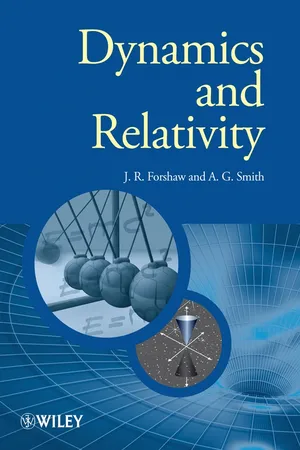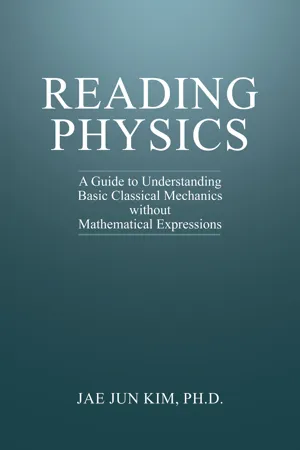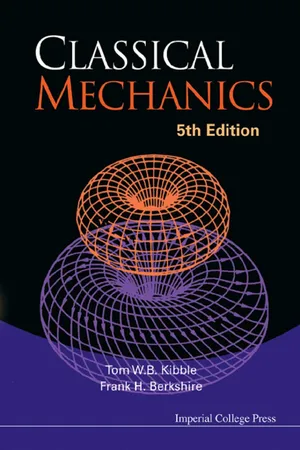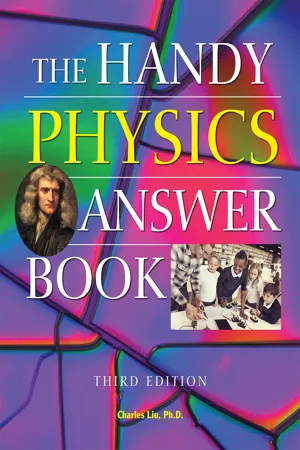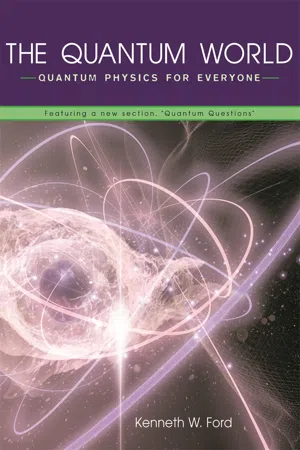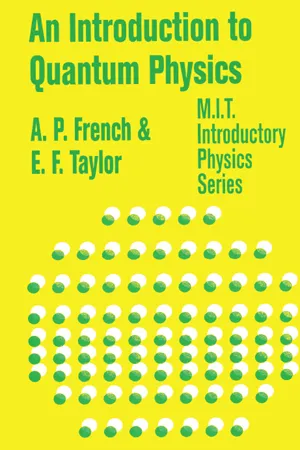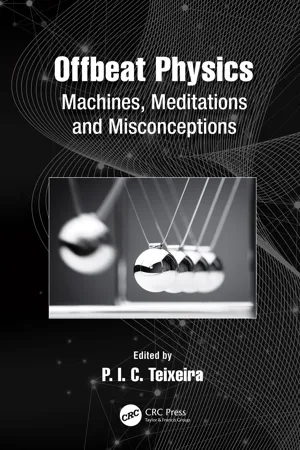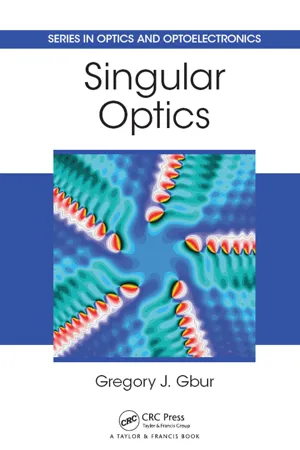Physics
Conservation of Angular Momentum
Conservation of Angular Momentum states that the total angular momentum of a system remains constant if no external torque acts on it. This means that as long as no external forces are present, the total angular momentum of a system will remain unchanged. This principle is a fundamental concept in physics and is used to analyze the motion of rotating objects.
Written by Perlego with AI-assistance
Related key terms
11 Key excerpts on "Conservation of Angular Momentum"
- eBook - ePub
- Robert Lambourne(Author)
- 2019(Publication Date)
- CRC Press(Publisher)
Equation 4.45 to predict its rotational motion about the centre of mass. Thus, provided its initial condition is known in sufficient detail, it is possible to completely predict the subsequent motion of the body. The past does, according to classical Newtonian mechanics, determine the future.Although we have now arrived at a general scheme for predicting rotational motion, we shall not pursue it here. Instead, we devote the rest of the chapter to topics that further illustrate the significance of Equation 4.45 and emphasize the enormous importance of angular momentum in almost all rotational phenomena.5.4 Conservation of Angular MomentumEquation 4.45 shows that in the absence of any net external torque (Γ= 0), the angular momentum of a rotating rigid body does not change with time, so L is a constant vector. That is to say it is a conserved quantity. This is a special case of a more general law of Conservation of Angular Momentum which may be stated as follows:For any system, the total angular momentum about any point remains constant as long as no net external torque acts on that system.This belongs with the conservation of energy and the conservation of linear momentum as one of the fundamental conservation principles that constrain the behaviour of the physical world.The rest of this subsection is devoted to examples of angular momentum conservation. Most of the systems we discuss will be free of external torques, but that does not mean there are no torques at all. A system may produce internal - eBook - ePub
- Jeffrey Forshaw, Gavin Smith(Authors)
- 2014(Publication Date)
- Wiley(Publisher)
Eq. (4.17) is not hard to understand. If it did not hold then the angular momentum of a body could change even if no external torques act upon it and that would lead to the bizarre result that isolated bodies could spontaneously start to rotate. We have thus arrived at a statement of the principle of Conservation of Angular Momentum:In the absence of external torques, the total angular momentum of a system is a conserved quantity.4.3 ANGULAR MOMENTUM AND ROTATION ABOUT A FIXED AXIS
We have so far succeeded in finding an equation of motion that relates the angular momentum to the net external torque. Our task in this section is to make more explicit the link between the angular momentum and the spin of the rotating body. To help simplify matters we will assert that the system of particles constitutes a rigid body. By this we mean that the relative positions of the particles that make up the body are fixed. Furthermore, we will make the restriction that the body is rotating about an axis that has a fixed direction in space. Examples of rotation of a body about a fixed axis are plentiful: a CD on a CD player rotates about a fixed axis through the centre of the CD; a yo-yo as it falls rotates about an axis whose direction is fixed, even though the yo-yo is accelerating downwards; the rear wheel of a bike shows fixed-axis rotation as long as the bike is travelling in a straight line (when the cyclist takes a bend the direction of the rotation axis is no longer fixed but changes as the direction of the bike’s motion changes). We shall widen our brief to include rotations about non-fixed axes in Chapter 10.Figure 4.3 Fixed-axis rotation.We therefore focus our attention upon the rotation of a rigid body about an axis that we define to be the z -axis. Figure 4.3 illustrates the geometry. Particle j has position vector rj , mass m j and is rotating about the z -axis with angular speed ω . Since the body is rigid we can be sure that the value of ω is the same for all particles. Furthermore, each particle executes a circular orbit of radius d j and we can use Eq. (1.24) - eBook - ePub
- A. L. Stanford, J. M. Tanner(Authors)
- 2014(Publication Date)
- Academic Press(Publisher)
For example, if the rotation of a body in a problem takes place about a fixed axis, the problem involves pure rotation; we may then ignore any translational aspects of the rotating body. The kinetic energy of the body is then given by K = 1/2 I ω 2. If the system under consideration is a rigid body rotating about a fixed axis, any particle located at a distance r from the axis of rotation has translational displacement, tangential speed, and tangential acceleration related to its angular variables by s = r θ, v t = r ω, and a t = r α. If a rotating body in a problem is not rigid, that is, if the distances between particles that comprise the body change, the problem is probably one that utilizes the principle of Conservation of Angular Momentum. Before we conclude that the angular momentum of a system is conserved, we must be certain that external forces produce no net torque on the system (the necessary condition for Conservation of Angular Momentum). When angular momentum of a system is conserved, the equation I i ω i = I f ω f relates the angular velocities and moments of inertia of the system before (initially) and after (finally) the configuration has been changed to give the system a different moment of inertia. Rolling (or unwinding) bodies translate and rotate simultaneously. If they roll without slipping, the equations s = r θ, v t = r ω, and a t = r α relate the translational and rotational variables of points on or within the rolling body - eBook - ePub
The Natural Law of Cycles
Governing the Mobile Symmetries of Animals and Machines
- James H. Bunn(Author)
- 2017(Publication Date)
- Routledge(Publisher)
explanatory example of the ways that physicists can transpose or carry over its unchanging characteristics as a principle to different areas of physics. As he says, conservation, as in conservation principle, “just means that it does not change” (1965, 48). Feynman is always down to earth in downplaying the possible mystique of the terms and concepts of physics. Here too, with constancy, is where symmetry enters. As Feynman says later, “a thing is symmetrical if there is something that you can do to it so that after you have finished doing it, it looks the same way as it did before. That is the sense in which we say that the laws of physics are symmetrical” (84). Note that now physics and symmetry, conservation and geometry, should go together. A child can rotate an ice cream cone around its vertical axis, pleasurably licking its drips, but if she rotates it upside down, or wobbles it to one side and another, it is unsymmetrical, and the ice cream sadly plops out and falls. So rotational momentum is applicable as an energy conservation principle or a symmetry principle, depending on the point of view that you are solving for. In order to show how rotational angular momentum can be carried over to different kinds of physics, Feynman starts a brief history of its use with Newton’s gravitational principle.In order to begin to explain Newton’s thinking about the motion and force of circling planets, Feynman, like George Darwin, begins with the stone whirling around on a string. Notice that he uses the shared experience of the pull of centripetal force, without giving the concept its name. He says one can measure the speed-up or acceleration of the in-pulling stone or planet as it is pulled sideways off a straight-line path:For instance if one has a stone on the end of a string and swings it in a circle over the head, one finds one has to pull, the reason is that although the speed is not changing as it goes round in a circle, it is changing in direction; there must be a perpetually in-pulling force, and this is proportional to the mass. (18–19)What happens when one takes two objects of different masses and whirls them on a string and then measures them successively? At the beginning, notice that the geometry of the problem is seen as a measure between the arc of a rotation as part of the circle, which will be measured by the radius squared, and the off-angled line of the in-pulling force. So, at the start, we are about to measure rotational momentum with a geometry of a triangle and a circle. - eBook - ePub
Reading Physics
A Guide to Understanding Basic Classical Mechanics without Mathematical Expressions
- Jae J. Kim(Author)
- 2023(Publication Date)
- Universal Publishers(Publisher)
Linear momentum is defined as the mass of an object times the velocity of the object. So, it is a vector. But we have a slightly different situation for angular momentum. Since the angle does not have any physical dimension associated with, angular momentum cannot be defined the same way as linear momentum. Question: what do we need to do? Answer: We need to bring the dimension length back into the definition. For that reason, angular momentum is defined as the mass associated with an object times the cross-product of the velocity and the position vector associated with the object. Why is this important? Just like the linear momentum in linear motion, angular momentum is conserved in an isolated system. On top of that, some intrinsic properties associated with momentum in both type of motions have similarities, and we are going to go over them later.So, if angular momentum is a counterpart for linear momentum, then how about energy in a rotational motion? Yes, there is energy associated with rotational motion, just like energy associated with linear motion. In a linear motion, we have two different types of energy, kinetic and potential energy. The former is a quantity that has to do with an object being in motion, and the latter has to do with the distance and something to be realized later in other forms of energy. Again, the potential energy has something to do with the distance and is not associated with motion, and it is going to be the same for both the linear and the rotational motion.But it is for kinetic energy that we need to differentiate the two different types of the motions. In terms of linear velocity, the kinetic energy happens to be proportional to velocity squared. In terms of angular velocity and other quantities in rotational motion, the same energy can be defined by what? Yes, it is going to be defined in terms of the moment of inertia. It is going to be proportional to the size of the moment of inertia and the size of the angular velocity squared. Remember: All you need to do when studying rotational motion in classical mechanics is replace the variables that you have studied in linear motion with those for rotational motions. - eBook - ePub
- Tom W B Kibble, Frank H Berkshire(Authors)
- 2004(Publication Date)
- ICP(Publisher)
G. Thus we obtain the important result that the rate of change of the angular momentum is equal to the moment of the applied force:This should be compared with the equation = F for the rate of change of the linear momentum.Since the definition of the vector product (see Appendix, §A.3 ) depends on the choice of a right-hand screw convention, the directions of the vectors G and J also depend on this convention. A vector of this type is known as an axial vector. It is to be contrasted with an ordinary, or polar, vector. Axial vectors are often associated with rotation about an axis. What is specified physically is not the direction along the axis, but the sense of rotation about it (see Fig. 3.1 ).3.4Central Forces; Conservation of Angular Momentum
An external force is said to be central if it is always directed towards or away from a fixed point, called the centre of force. If we choose the origin to be this centre, this means that F is always parallel to the position vector r. Since the vector product of two parallel vectors is zero, the condition for a force F to be central is that its moment about the centre should vanish:From (3.21) it follows that if the force is central, the angular momentum is a constant:This is the law of Conservation of Angular Momentum in its simplest form. It really contains two statements: that the direction of J is constant, and that its magnitude is constant. Let us look at these in turn.The direction of J is that of the normal to the plane of r and v = . Hence, the statement that this direction is fixed implies that r and v must always lie in a fixed plane. In other words, the motion of the particle is confined to the plane containing the initial position vector and velocity vector (see Fig. 3.2 - eBook - ePub
- Charles Liu(Author)
- 2020(Publication Date)
- Visible Ink Press(Publisher)
An object with linear momentum that has no external forces on it cannot change its mass, so its velocity is constant. But a rotating object can change its moment of inertia, so, even without external torques, its rotational speed can be changed.What is the significance of the Conservation of Angular Momentum?
In the absence of external torques, if the moment of inertia of a rotating object gets smaller, its rate of rotation speeds up and vice versa. This applies especially to astrophysical systems, where strong external torques are rare. For example, when a big star collapses into a tiny white dwarf or neutron star, it can start spinning around dozens or even hundreds of times per second, creating a pulsar. In the other direction, the length of a lunar month has increased as the moon’s distance from Earth has gradually increased over billions of years.How is angular momentum used in sports?
Let’s explore two different sports. In platform diving, a diver pushes off the tower, and thus, the platform exerts a force on her (Newton’s Third Law). If she isn’t standing straight up, the force also exerts a torque on her, which starts her rotating. If she pulls her arms and legs in, then her mass comes closer to her axis of rotation, and her speed of rotation increases. To slow this rotation, she can extend her arms and legs. With good timing, she can hit the water with a bare minimum of rotation.Put a toy gyroscope on a stand and spin the wheel. Gravity pulls down on the center of gravity of the gyroscope, creating a torque on the axis of rotation, causing it to rotate downward.Next, let’s consider a figure skater. She can start spinning on the point of one skate by pushing on the ice with the second skate. Again, the force of the ice exerts a torque, and so her rotational speed increases. She can extend her arms to slow the rotation or pull them in as close as possible to attain a very high spin rate.What happens when an axis of rotation tilts?
A toy gyroscope contains a rotating wheel. If you put it on a stand, the axis moves in a circle. Why? The gravitational force pulls down on the center of mass of the wheel. Thus, the gyroscope begins to rotate downward. The effect of this new torque is to cause the axis to change direction. This kind of tilting is called precession. - eBook - ePub
The Quantum World
Quantum Physics for Everyone
- Kenneth W. Ford(Author)
- 2005(Publication Date)
- Harvard University Press(Publisher)
Conservation laws are relative newcomers in the history of physics. Aristotle, like Euripides and Heraclitus before him, focused principally on change. So did most scientists until the modern era. Johannes Kepler, with his second law of planetary motion, may have introduced the first conservation law, at the beginning of the seventeenth century. This law says that a hypothetical line drawn from the Sun to a planet sweeps out equal areas in equal times. The planet moves faster when it comes closer to the Sun and slower when it is farther from the Sun, always varying its speed in just such a way that the rate at which the radial line is sweeping out area is constant. Now we understand Kepler’s second law to be a consequence of angular-momentum conservation. As each planet pursues its orbit, some of its features vary—its speed, its direction of motion, its distance from the Sun—but its orbital angular momentum remains constant. The Earth’s reliable turn about its own axis once every twenty-four hours is also a consequence of angular-momentum conservation, in this case spin angular momentum.Not long after Kepler’s work, Galileo Galilei recognized that an object free of outside influences moves indefinitely at constant velocity—a kind of conservation law. Later in the seventeenth century, Christiaan Huygens and Isaac Newton introduced momentum conservation, although Newton, in his great work on motion, still focused mainly on change. Benjamin Franklin’s proposal of charge conservation came in the eighteenth century. The most dramatic step toward assigning primacy to conservation laws came in the mid-nineteenth century, when scientists proposed the general law of energy conservation, encompassing both mechanical energy and heat energy. At the time, chemists were relying on the law of mass conservation. This law crumbled in Einstein’s hands. With his famous formulaE = mc2 - eBook - ePub
- A.P. French(Author)
- 2018(Publication Date)
- Routledge(Publisher)
11 Angular momentum of atomic systems 11-1 INTRODUCTIONIn Chapter 10 we described experimental evidence that atomic angular momentum is quantized, estimated the value of atomic magnetic moments, began a formal analysis of orbital angular momentum, and applied this analysis to the orbital angular momentum of a two-dimensional simple harmonic oscillator. In the present chapter we extend the analysis of orbital angular momentum to three dimensions and introduce the spin angular momentum of the electron. With these tools we can then “return with power” to describe real atoms and molecules.11-2 TOTAL ORBITAL ANGULAR MOMENTUM IN CENTRAL FIELDS The Classical Equation for Central Force MotionWe now extend to three dimensions the analysis of orbital angular momentum in a central force field. We are familiar with the fact that the time-independent Schrödinger equation is closely related to the classical equation for the total energy of a particle in a given potential. Therefore it is helpful to begin by considering what classical mechanics can tell us about angular momentum in three dimensions. Now classically, if the potential is central, it is advantageous to analyze the motion at any instant into components along the position vector r and transverse to this direction (Figure 11-1 ). If the radial and transverse velocity components are labeled vr and vt respectively, the classical energy equation is1Fig. 11-1 Resolution of a velocity vector into radial and transverse components with respect to a center of attraction at O.1 2Mυ r2 +1 2M υt t2 + V ( r ) = EHowever, we know that the total angular momentum L - eBook - ePub
Offbeat Physics
Machines, Meditations and Misconceptions
- P.I.C. Teixeira(Author)
- 2022(Publication Date)
- CRC Press(Publisher)
ω . These examples stress that if we state that a central force leads to Conservation of Angular Momentum, we must specify that the angular momentum is calculated about the center of motion.The choicea = b = c = 0supports the students' objection that the complications in Eq. (16.7) have arisen from a bad choice for O. The next example shows that a simple alteration makes it impossible to find an ideal choice for O.16.3 Angular momentum of two particles describing circular motion
Consider the two particles shown in Fig. 16.2 , which rotate in free space around a common axis z, with the same angular velocity ω, in two parallel planes at a vertical distance 2d from each other. The particles rotate such that they always lie on opposite sides of the axis (i.e., the two particles are out of phase by π). The system as a whole may be viewed as a dumbbell rotating around an axis which makes an anglearctan ( R / d )with the axis of the dumbbell.FIGURE 16.2Point particles of mass m describing a circular motion of radius R, centered at a common axis with constant angular velocity ω. The particles are always on opposite sides of the axis.The total angular momentum of the system about a point O is given by the sum of the two angular momenta, each calculated in Sec. 16.2 for a generic point O. For the lower particle (particle 2) we could choose O to coincide with the center of its circular orbit, thereby simplifying its angular momentum to be. The result for the angular momentum of the upper particle (particle 1) is given by Eq. (16.8) withL O= mR 2ωc = 2 d. Alternatively, we could choose O to coincide with the center of particle 1's circular orbit. This choice would simplify its angular momentum but then, the angular momentum of particle 2 would be given by Eq. (16.8) withc = − 2 dandω t → ω t + π. In either description the total angular momentum is not parallel to ω - eBook - ePub
- Gregory J. Gbur(Author)
- 2016(Publication Date)
- CRC Press(Publisher)
orbital component of the angular momentum as well. This latter aspect was only put under serious scrutiny quite recently [ABSW92], possibly coinciding with the growth of singular optics as a field. Since then, there has been extensive research on the subject; see, for instance, the collection edited by Allen, Barnett, and Padgett [ABP03].The study of optical angular momentum comes with certain conceptual difficulties. Light is not a rigid or even massive body, leaving significant ambiguity on how to define the “axis” of rotation for orbital angular momentum (OAM). Furthermore, there is great uncertainty in how to describe the linear momentum of light, and therefore also the angular momentum, while it is traveling in matter, resulting in the 100-year-and-counting Ambraham–Minkowski controversy.Optical angular momentum plays an important role in both practical applications and natural phenomena. In astronomy, it has been observed that complicated light interactions with asymmetric asteroids can change the asteroids’ rotation, in what is known as the YORP effect (see, for instance, [LFP+ 07]). In microscopy, the momentum and angular momentum of light is now regularly used to trap and rotate small objects in a technique known as optical tweezing, to be discussed in some detail in Chapter 6 .In this chapter, we discuss both the momentum and angular momentum of light and conceptual challenges associated with them. We start by returning to Maxwell’s equations and deriving the appropriate conservation laws in terms of electric and magnetic fields.5.1 MOMENTUM AND ANGULAR MOMENTUM IN WAVEFIELDSWe begin by considering a region of space that contains time-fluctuating electric and magnetic fields E(r, t) and B(r, t). Let us consider the force F(r, t) on a point particle of charge q
Index pages curate the most relevant extracts from our library of academic textbooks. They’ve been created using an in-house natural language model (NLM), each adding context and meaning to key research topics.

